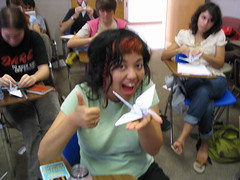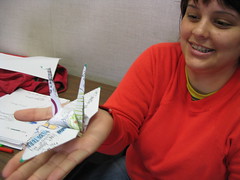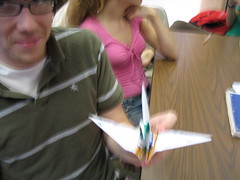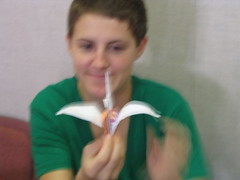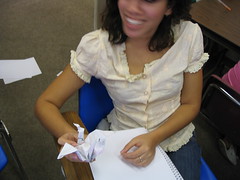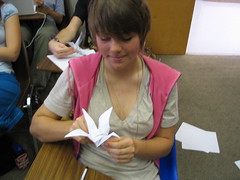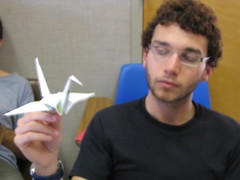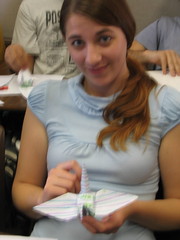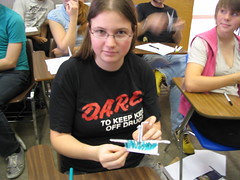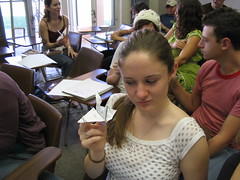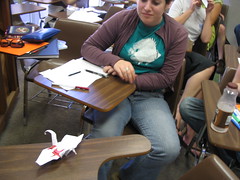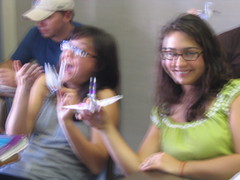Wednesday, February 28, 2007
Hmmm.
Sorry.
Tuesday, February 27, 2007
I found "A Humument" to be surprisingly engaging, as traditional forms of peotry are abandoned and rather than meter, rhyme and structure creating a flow to the language, the active pull of the visualization of a complete poem on a scattered page of words is what pulls you through the work. As I was reading the book at first, I observed what seemed to be a poem about the act of making poetry, and then seemed to be about the associations of love with poetry. As I got further and discovered the implication of a narrative, I discovered that what I was reading was the personal expressions of the author on and about the creation of poetry through himself and the character 'toge', who is both the creation of his poetry and also a representation of himself. The narrative, if that's what you can call it, vaguely follows a poetically inclined life through it's ups and downs and the kinds of life experiences thet engendre poetry in the first place. In the style of the epic, each page is a snapshot of a moment, or an experience, or a feeling that could not be expressed. Also much like an epic, as the book moves further on the author brings in other characters who are captured in the midst of their experiences of life in the pages of his book, and every person experiences life differently so he brings new colors and tones into his poetry as he adds new (or old) characters, both in a literary and a perfectly literal sense made possible by the visual execution of the work.
The poetry also makes me curious about the book, as while the poetry does not follow the characters of "A Human Document", it very obviously follows the emotional tone of the book, given the useable repetitions of words that appear in the poetry. The language that we use is part of how one creates a mood in a poem or a book, and the author is using the language that was already available, which leaves me inclined to believe that he read the Victorian novel as it was written and saw the potential for something else hidden in it's pages. The book as it has been presented to us appears to be about the evolution of poetry through life and conversly the expression of life as poetry. "I am sad and so I write poetry, but also I am sad and that in and of itself is poetry", the true poet sees poetry everywhere. It is a poetical expression of life, love, art, the travails of the writer, the pain in the world that makes beauty beautiful, and the fluidity of all things as life and experiences overlap to form systems of ups and downs that our classically trained minds experience as poetry and art. The visual aspect is facinating as he uses it for stops, pauses, tone, and the almost forceful dragging of the reader through the book much as one lyrically trickles through a Frost poem. Given the disconnected and haphazard word placement on the pages, the art is also like a guide, and is the only reason the poetry makes sense.
I quite liked it. It was like a playground for my brain.
Saturday, February 24, 2007
Wednesday, February 21, 2007
A Humument
As we continue jump to dynamic ideas, the title begins to support the general presence of the text as the reflection fo a human being in all of his scattered details. Yet the visual proves a little distracting in its chaos. On many pages atterns and shapes are haphazardly arranged despite the lack of any visual connection to the poems. Some of the pictures bring to mind the doodles the appear through an anxious state of boredom, or as a means of destraction from the task at hand.
However, Tom Phillips may consciously be undermining man's sincerity that sporaticaly appears through A Humument. This could prove to be a successful literary tool if only the character were defined more or if the images were more consistently adolescent. Overall the scattered visual and poetic elements reveal a dominanting feature in the human conscious with a tone of sarcastic belittlement, to me.
Tuesday, February 20, 2007
The Humument
As far as issues of narrative within The Humument go, there seems to be a very vague narrative, or at least a series of connected ideas. While there are a few characters that pop in and out of the book and each page has some bearing on the ones before and after it, there isn’t what could be traditionally considered a story. This, in part, is where it seems to be most poetic. The abstraction of the narrative and the events happening in whatever narrative there is can be attributed to The Humument’s poetics.
Also of note is the attention given to The Humument’s visual component. The visuals on each page seem to be more carefully considered than any of the traditionally poetic elements of it (i.e. word choice). This brings up concerns over the correlation of any visual element of a page to the particular words chosen to be singled on the page. The visuals on each page are notably distinct from the visuals on the other pages and seem to be set up to distinctly relate to the words chosen on the particular page. For instance, a page in which abstract art is mentioned, a representation of abstract art is presented on the page.
Notable is page 73 on which there appears to be relatively no visual element to the poetics of the page, although if one looks close, Tom Phillips has cut up and mixed up words to describe a particular sex scene and make a lot of sex jokes. Within the context of the work as a whole, this seems to work really well since it draws attention to itself as a piece of text rather than having a very important visual element to it. When one reads the actual text on the page, it’s really funny with various “ughs” inserted throughout the text and words cut up to be assembled into the words “cock tease”. Since the actual text on the page is meant to be considered as a whole, the choice to not include any immediately visible visual manipulation seems to be a wise one.
Thursday, February 15, 2007
Wednesday, February 14, 2007
Humument
The primary themes evident throughout this text are those of erotic impressions (my favorite occurs on page 244, on which the text “ceaseless sliding tower burnished piston-rising and falling, fully the perfect skill of man” appears in the forefront of a not-so-subtle phallic “tower”), a certain “Toge” and his struggle with coalescing the struggles of love with the joys of art, connections to “Irma,” and expressions of creativity. The reoccurrence of these themes formed what I found to be a sort of false narrative. While there is a roundabout way to follow the subjects and ideas throughout the text, any direct proclamation of a storyline is, to me, incorrect.
I believe the main conflict within this work was that of how to express creativity. Is it through love, as is insinuated periodically, or is it best portrayed in art or poetry? By combining expressions of all three in this text, the author effectively conveyed this conflict, meaning the art ultimately added to the story.
Tuesday, February 13, 2007
The book reminded me of a comic strip in the way that they both use the idea of a polyptych. The main difference being that the understanding one can gain from viewing the pictures of a comic alone is much greater than that gained from viewing the visuals of Humument. I've drawn the conclusion that the only way I feel comfortable talking about the book at this point is in relation to other things.
Humument
When one goes to read a novel they are expected to go progressively page by page. When one reads a poetry anthology the form suggests the possibility of an important for reading order but this isn’t always necessary. Reading an artists monograph is different as well. The images stand coherently on there own and can be addressed individually as well as in different orders. With the considerations of how an audience approaches different forms it is interesting to think about how the form of a book dictates how it is read. From this inquiry one can then address the question of narrative.
I first approached the book as a novel. There seemed to be a sort of narrative and maybe a romantic interaction between two character. I also read a large portion of the book out of order. Many of the pages seemed to stand of the context of others. This approach is helped by the visuals with stand very distinctly from one an other as opposed to sequential design/cartoons.
Do the visuals distract?
Having said that the form of the book yields different meanings depending on the interpretation of its form, the visuals steer the viewers to addressing pages as individual pieces. The visual aspect of the book as well as the form of the text makes the order puzzling as well. But the order, meaning, and interpretation of certain pages is guided by the visuals.
More importantly than the factor of the narrative I find it interesting that the author/artist is critiquing the layers of meaning possible within art/literature. The work functions off of a variety of levels: language, novel, poem, picture, and the increasing editing of the work itself. It is interesting to acknowledge each layer as well as there interplay.
